Business Accounting: Solved Assignments and Essays - Desklib
VerifiedAdded on 2023/06/18
|15
|3486
|297
AI Summary
The article contains solved assignments and essays on Business Accounting. It includes topics such as dual aspect effect, trial balance, profit and loss, capital and revenue expenditure, sales ledger control account, and more. The article also provides comments on the ratios computed in light of the data of the industry. The subject is relevant to various courses and universities.
Contribute Materials
Your contribution can guide someone’s learning journey. Share your
documents today.

Accounts
Secure Best Marks with AI Grader
Need help grading? Try our AI Grader for instant feedback on your assignments.
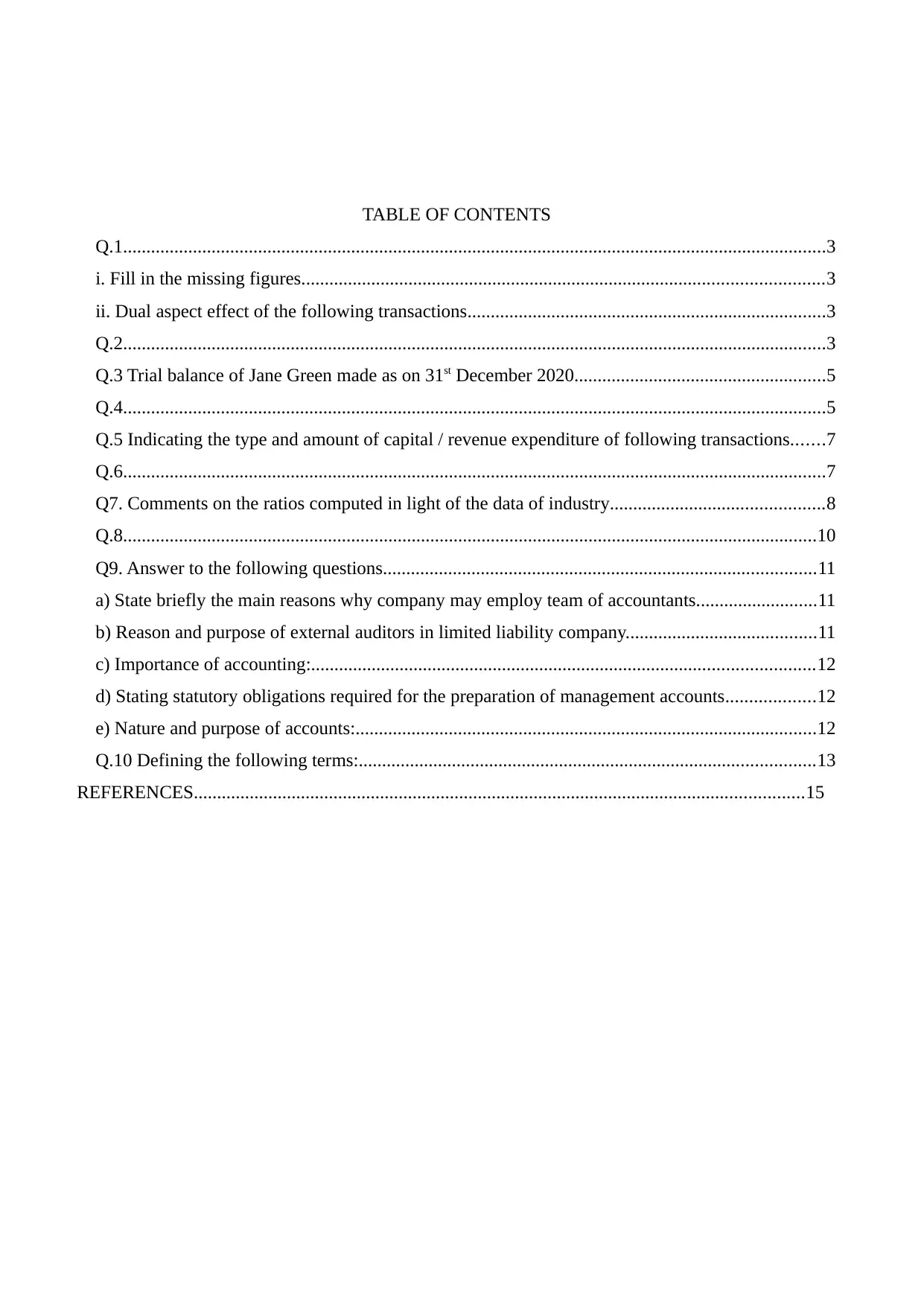
TABLE OF CONTENTS
Q.1.......................................................................................................................................................3
i. Fill in the missing figures................................................................................................................3
ii. Dual aspect effect of the following transactions.............................................................................3
Q.2.......................................................................................................................................................3
Q.3 Trial balance of Jane Green made as on 31st December 2020......................................................5
Q.4.......................................................................................................................................................5
Q.5 Indicating the type and amount of capital / revenue expenditure of following transactions.......7
Q.6.......................................................................................................................................................7
Q7. Comments on the ratios computed in light of the data of industry..............................................8
Q.8.....................................................................................................................................................10
Q9. Answer to the following questions.............................................................................................11
a) State briefly the main reasons why company may employ team of accountants..........................11
b) Reason and purpose of external auditors in limited liability company.........................................11
c) Importance of accounting:............................................................................................................12
d) Stating statutory obligations required for the preparation of management accounts...................12
e) Nature and purpose of accounts:...................................................................................................12
Q.10 Defining the following terms:..................................................................................................13
REFERENCES...................................................................................................................................15
Q.1.......................................................................................................................................................3
i. Fill in the missing figures................................................................................................................3
ii. Dual aspect effect of the following transactions.............................................................................3
Q.2.......................................................................................................................................................3
Q.3 Trial balance of Jane Green made as on 31st December 2020......................................................5
Q.4.......................................................................................................................................................5
Q.5 Indicating the type and amount of capital / revenue expenditure of following transactions.......7
Q.6.......................................................................................................................................................7
Q7. Comments on the ratios computed in light of the data of industry..............................................8
Q.8.....................................................................................................................................................10
Q9. Answer to the following questions.............................................................................................11
a) State briefly the main reasons why company may employ team of accountants..........................11
b) Reason and purpose of external auditors in limited liability company.........................................11
c) Importance of accounting:............................................................................................................12
d) Stating statutory obligations required for the preparation of management accounts...................12
e) Nature and purpose of accounts:...................................................................................................12
Q.10 Defining the following terms:..................................................................................................13
REFERENCES...................................................................................................................................15

Q.1
i. Fill in the missing figures.
Assets Liabilities Capital
€ € €
a 20000 0 20000
b 15000 5000 10000
c 16400 7550 8850
d 14100 3850 10250
e 25380 18430 6950
ii. Dual aspect effect of the following transactions.
Assets= liabilities + capital
Assets Liabilities Capital
€ € €
a 8000 0 8000
b 4000 4000 0
c 3000 3000 0
d 6000 6000 0
e 0 0 0
Total 21000 13000 8000
Q.2
Cash account
Date Particulars Amount (in £) Date Particulars Amount (in £)
01/01/21 to bank 25000 to balance b/d 31000
10/01/21 to sales 6000
31000 31000
Bank account
Date Particulars Amount (in £) Date Particulars Amount (in £)
to balance b/d 31000 01/01/21 by cash 25000
02/01/21 by rent 2000
04/01/21 by motor car 4000
31000 31000
Purchase account
Date Particulars
Amount (in
£)
Dat
e Particulars
Amount (in
£)
03/01/2
1 to linda a/c 5000
by balance
b/d 8000
05/01/2
1 to sydney 3000
i. Fill in the missing figures.
Assets Liabilities Capital
€ € €
a 20000 0 20000
b 15000 5000 10000
c 16400 7550 8850
d 14100 3850 10250
e 25380 18430 6950
ii. Dual aspect effect of the following transactions.
Assets= liabilities + capital
Assets Liabilities Capital
€ € €
a 8000 0 8000
b 4000 4000 0
c 3000 3000 0
d 6000 6000 0
e 0 0 0
Total 21000 13000 8000
Q.2
Cash account
Date Particulars Amount (in £) Date Particulars Amount (in £)
01/01/21 to bank 25000 to balance b/d 31000
10/01/21 to sales 6000
31000 31000
Bank account
Date Particulars Amount (in £) Date Particulars Amount (in £)
to balance b/d 31000 01/01/21 by cash 25000
02/01/21 by rent 2000
04/01/21 by motor car 4000
31000 31000
Purchase account
Date Particulars
Amount (in
£)
Dat
e Particulars
Amount (in
£)
03/01/2
1 to linda a/c 5000
by balance
b/d 8000
05/01/2
1 to sydney 3000
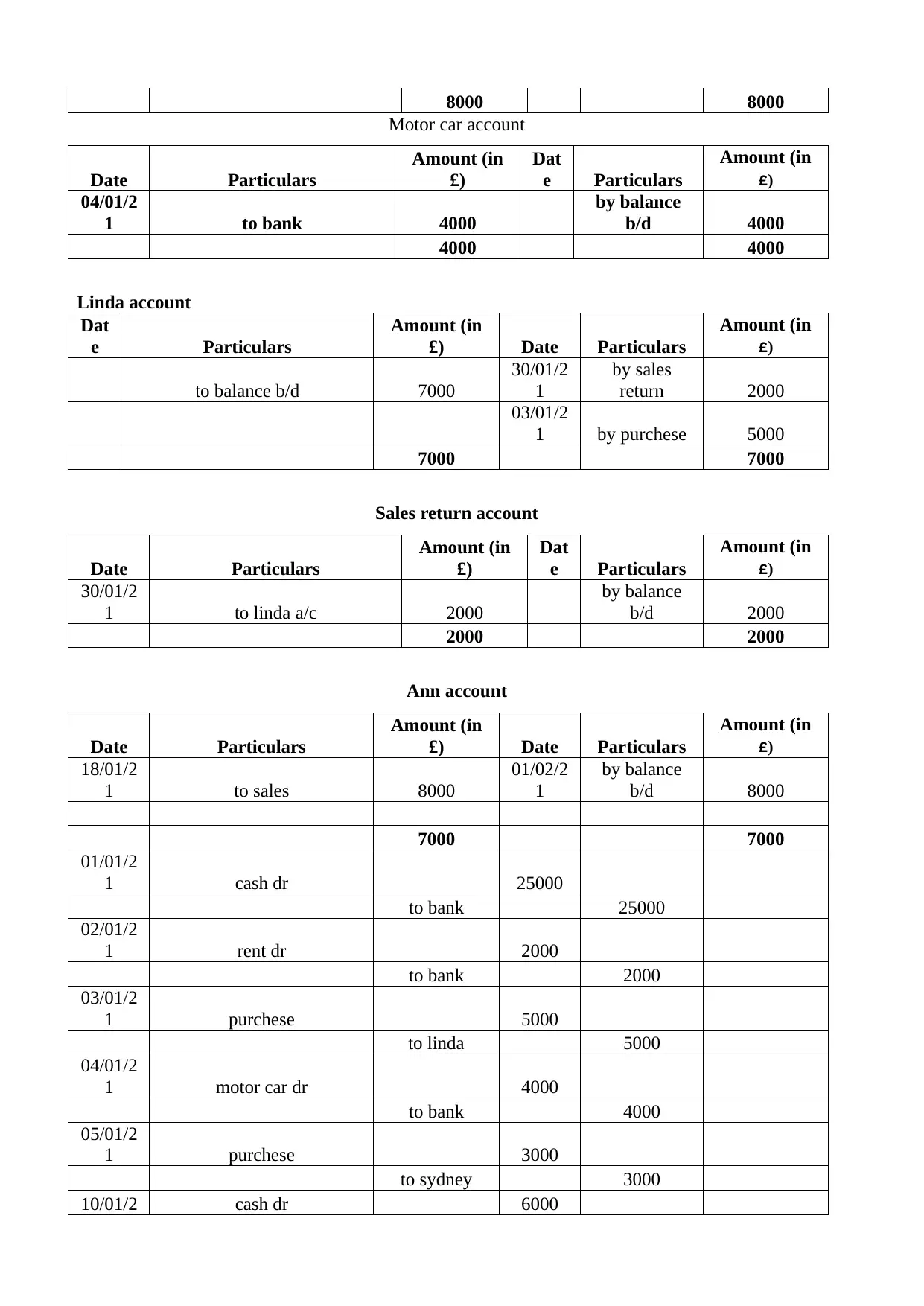
8000 8000
Motor car account
Date Particulars
Amount (in
£)
Dat
e Particulars
Amount (in
£)
04/01/2
1 to bank 4000
by balance
b/d 4000
4000 4000
Linda account
Dat
e Particulars
Amount (in
£) Date Particulars
Amount (in
£)
to balance b/d 7000
30/01/2
1
by sales
return 2000
03/01/2
1 by purchese 5000
7000 7000
Sales return account
Date Particulars
Amount (in
£)
Dat
e Particulars
Amount (in
£)
30/01/2
1 to linda a/c 2000
by balance
b/d 2000
2000 2000
Ann account
Date Particulars
Amount (in
£) Date Particulars
Amount (in
£)
18/01/2
1 to sales 8000
01/02/2
1
by balance
b/d 8000
7000 7000
01/01/2
1 cash dr 25000
to bank 25000
02/01/2
1 rent dr 2000
to bank 2000
03/01/2
1 purchese 5000
to linda 5000
04/01/2
1 motor car dr 4000
to bank 4000
05/01/2
1 purchese 3000
to sydney 3000
10/01/2 cash dr 6000
Motor car account
Date Particulars
Amount (in
£)
Dat
e Particulars
Amount (in
£)
04/01/2
1 to bank 4000
by balance
b/d 4000
4000 4000
Linda account
Dat
e Particulars
Amount (in
£) Date Particulars
Amount (in
£)
to balance b/d 7000
30/01/2
1
by sales
return 2000
03/01/2
1 by purchese 5000
7000 7000
Sales return account
Date Particulars
Amount (in
£)
Dat
e Particulars
Amount (in
£)
30/01/2
1 to linda a/c 2000
by balance
b/d 2000
2000 2000
Ann account
Date Particulars
Amount (in
£) Date Particulars
Amount (in
£)
18/01/2
1 to sales 8000
01/02/2
1
by balance
b/d 8000
7000 7000
01/01/2
1 cash dr 25000
to bank 25000
02/01/2
1 rent dr 2000
to bank 2000
03/01/2
1 purchese 5000
to linda 5000
04/01/2
1 motor car dr 4000
to bank 4000
05/01/2
1 purchese 3000
to sydney 3000
10/01/2 cash dr 6000
Secure Best Marks with AI Grader
Need help grading? Try our AI Grader for instant feedback on your assignments.
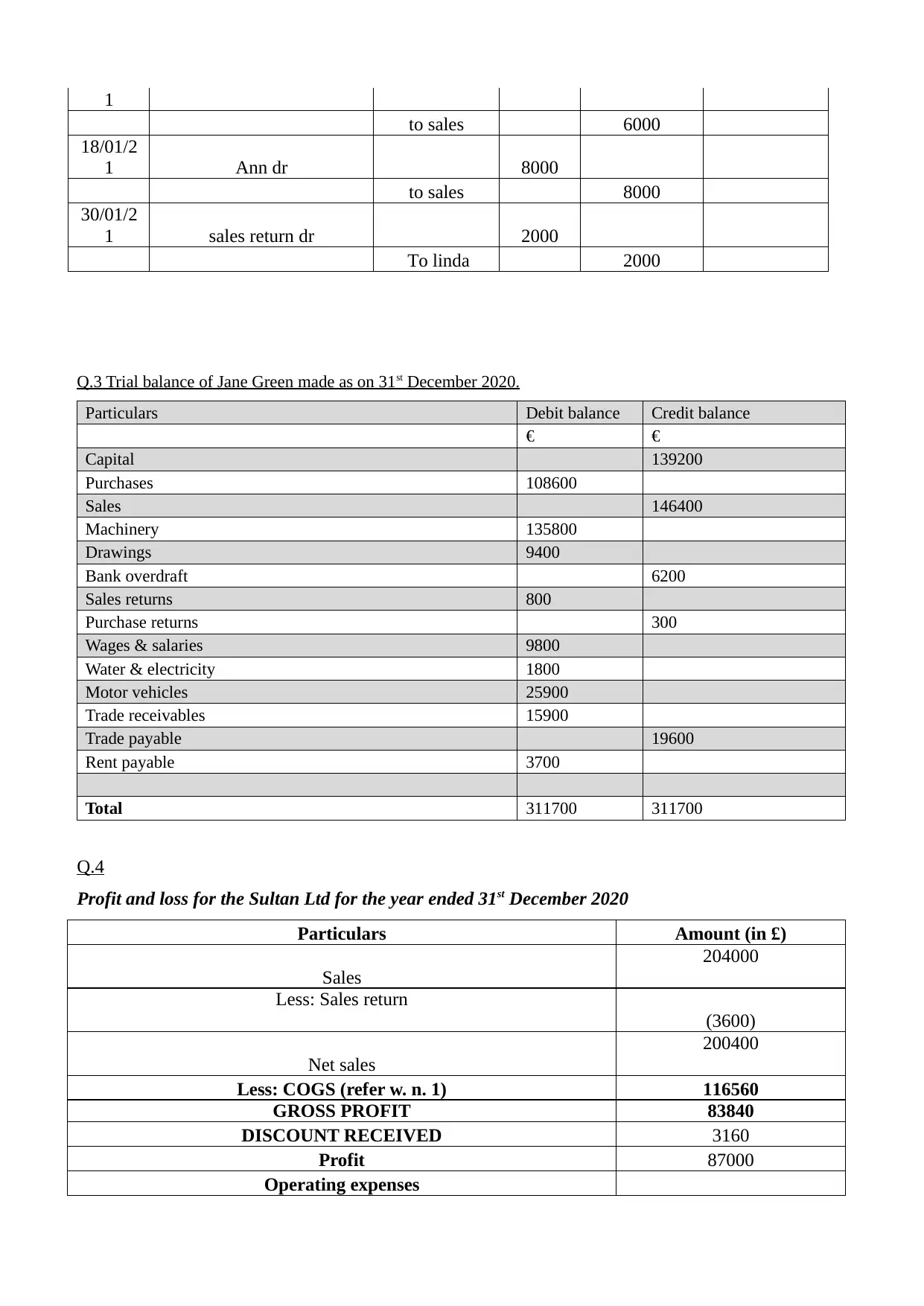
1
to sales 6000
18/01/2
1 Ann dr 8000
to sales 8000
30/01/2
1 sales return dr 2000
To linda 2000
Q.3 Trial balance of Jane Green made as on 31st December 2020.
Particulars Debit balance Credit balance
€ €
Capital 139200
Purchases 108600
Sales 146400
Machinery 135800
Drawings 9400
Bank overdraft 6200
Sales returns 800
Purchase returns 300
Wages & salaries 9800
Water & electricity 1800
Motor vehicles 25900
Trade receivables 15900
Trade payable 19600
Rent payable 3700
Total 311700 311700
Q.4
Profit and loss for the Sultan Ltd for the year ended 31st December 2020
Particulars Amount (in £)
Sales
204000
Less: Sales return
(3600)
Net sales
200400
Less: COGS (refer w. n. 1) 116560
GROSS PROFIT 83840
DISCOUNT RECEIVED 3160
Profit 87000
Operating expenses
to sales 6000
18/01/2
1 Ann dr 8000
to sales 8000
30/01/2
1 sales return dr 2000
To linda 2000
Q.3 Trial balance of Jane Green made as on 31st December 2020.
Particulars Debit balance Credit balance
€ €
Capital 139200
Purchases 108600
Sales 146400
Machinery 135800
Drawings 9400
Bank overdraft 6200
Sales returns 800
Purchase returns 300
Wages & salaries 9800
Water & electricity 1800
Motor vehicles 25900
Trade receivables 15900
Trade payable 19600
Rent payable 3700
Total 311700 311700
Q.4
Profit and loss for the Sultan Ltd for the year ended 31st December 2020
Particulars Amount (in £)
Sales
204000
Less: Sales return
(3600)
Net sales
200400
Less: COGS (refer w. n. 1) 116560
GROSS PROFIT 83840
DISCOUNT RECEIVED 3160
Profit 87000
Operating expenses
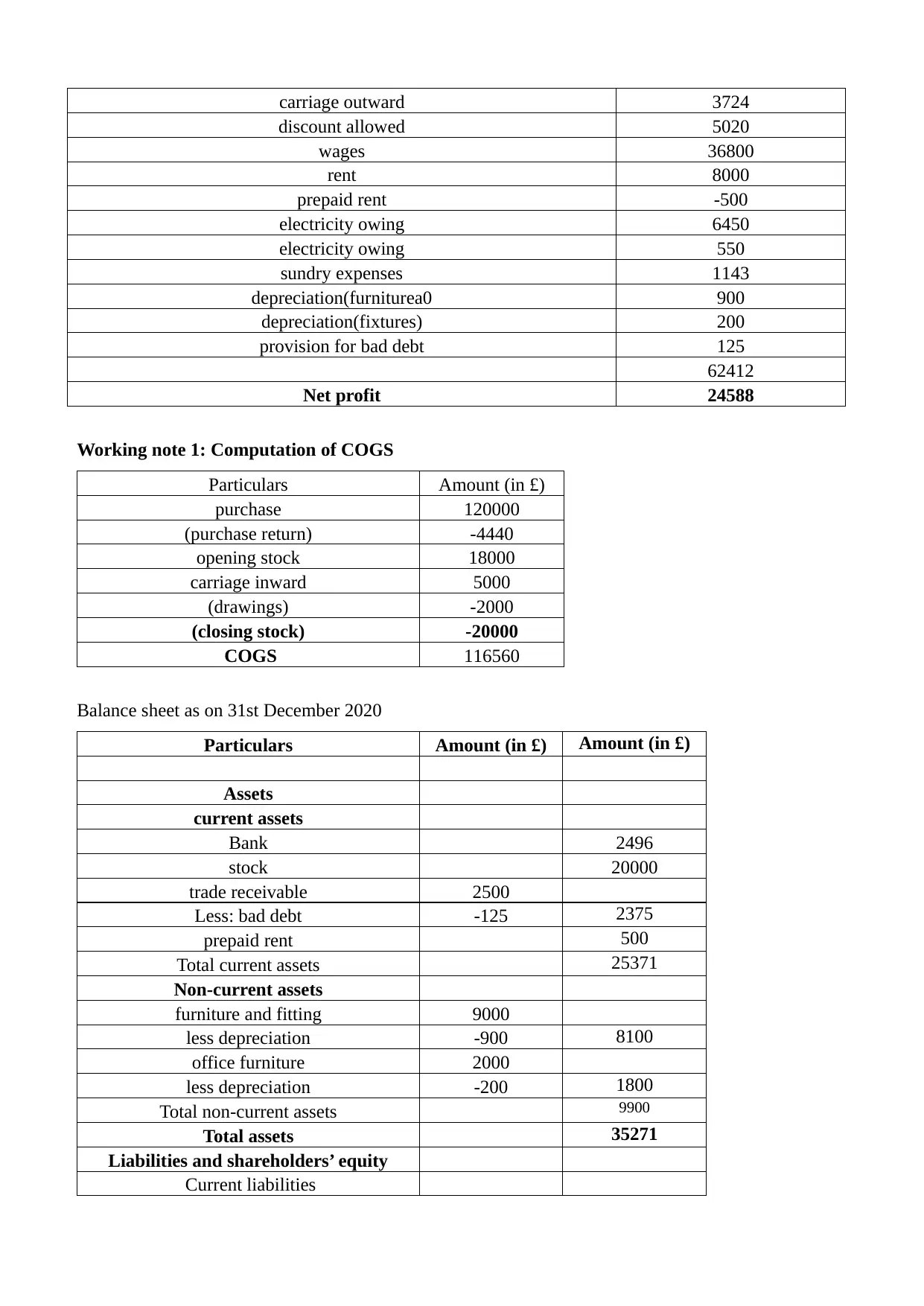
carriage outward 3724
discount allowed 5020
wages 36800
rent 8000
prepaid rent -500
electricity owing 6450
electricity owing 550
sundry expenses 1143
depreciation(furniturea0 900
depreciation(fixtures) 200
provision for bad debt 125
62412
Net profit 24588
Working note 1: Computation of COGS
Particulars Amount (in £)
purchase 120000
(purchase return) -4440
opening stock 18000
carriage inward 5000
(drawings) -2000
(closing stock) -20000
COGS 116560
Balance sheet as on 31st December 2020
Particulars Amount (in £) Amount (in £)
Assets
current assets
Bank 2496
stock 20000
trade receivable 2500
Less: bad debt -125 2375
prepaid rent 500
Total current assets 25371
Non-current assets
furniture and fitting 9000
less depreciation -900 8100
office furniture 2000
less depreciation -200 1800
Total non-current assets 9900
Total assets 35271
Liabilities and shareholders’ equity
Current liabilities
discount allowed 5020
wages 36800
rent 8000
prepaid rent -500
electricity owing 6450
electricity owing 550
sundry expenses 1143
depreciation(furniturea0 900
depreciation(fixtures) 200
provision for bad debt 125
62412
Net profit 24588
Working note 1: Computation of COGS
Particulars Amount (in £)
purchase 120000
(purchase return) -4440
opening stock 18000
carriage inward 5000
(drawings) -2000
(closing stock) -20000
COGS 116560
Balance sheet as on 31st December 2020
Particulars Amount (in £) Amount (in £)
Assets
current assets
Bank 2496
stock 20000
trade receivable 2500
Less: bad debt -125 2375
prepaid rent 500
Total current assets 25371
Non-current assets
furniture and fitting 9000
less depreciation -900 8100
office furniture 2000
less depreciation -200 1800
Total non-current assets 9900
Total assets 35271
Liabilities and shareholders’ equity
Current liabilities
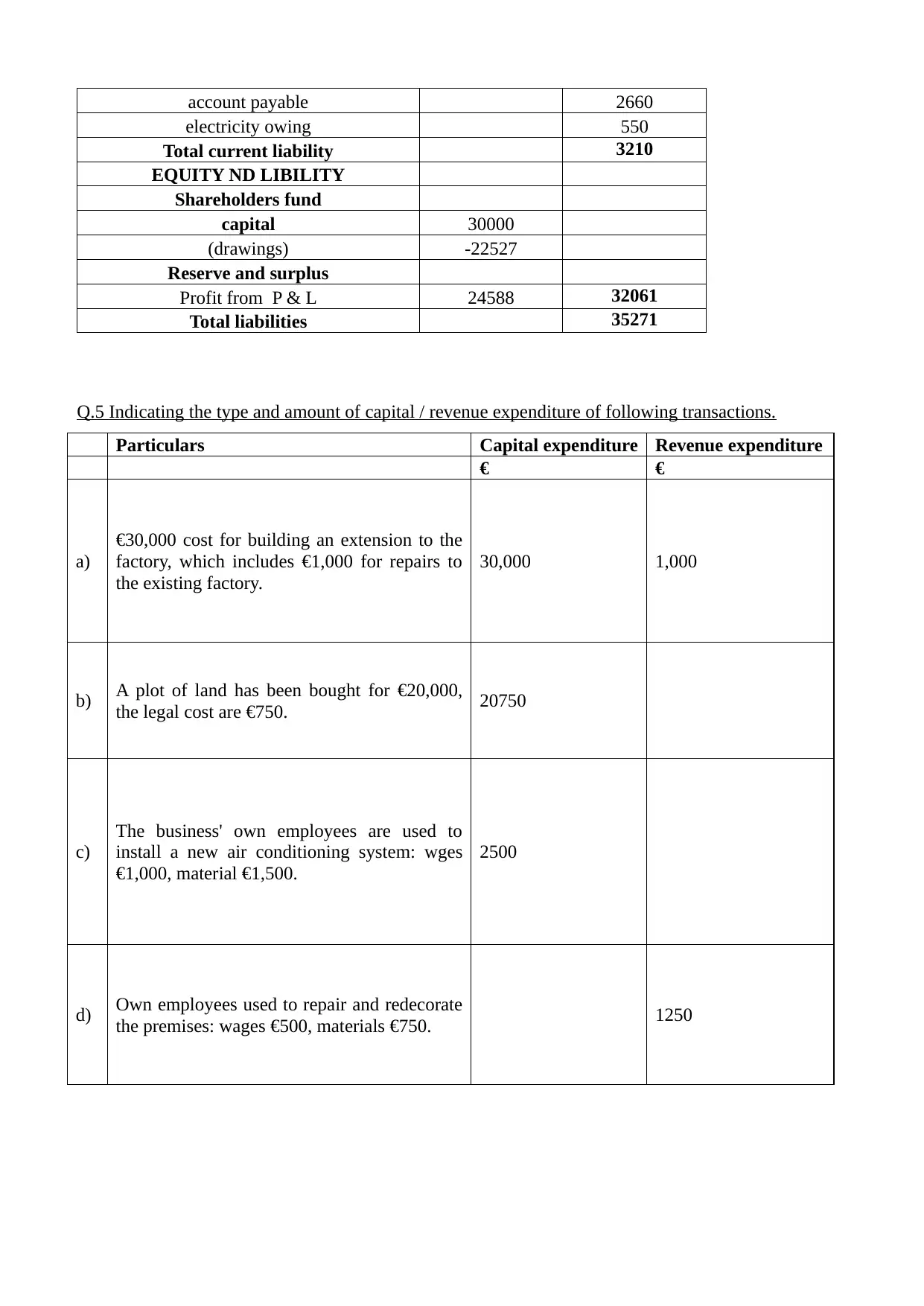
account payable 2660
electricity owing 550
Total current liability 3210
EQUITY ND LIBILITY
Shareholders fund
capital 30000
(drawings) -22527
Reserve and surplus
Profit from P & L 24588 32061
Total liabilities 35271
Q.5 Indicating the type and amount of capital / revenue expenditure of following transactions.
Particulars Capital expenditure Revenue expenditure
€ €
a)
€30,000 cost for building an extension to the
factory, which includes €1,000 for repairs to
the existing factory.
30,000 1,000
b) A plot of land has been bought for €20,000,
the legal cost are €750. 20750
c)
The business' own employees are used to
install a new air conditioning system: wges
€1,000, material €1,500.
2500
d) Own employees used to repair and redecorate
the premises: wages €500, materials €750. 1250
electricity owing 550
Total current liability 3210
EQUITY ND LIBILITY
Shareholders fund
capital 30000
(drawings) -22527
Reserve and surplus
Profit from P & L 24588 32061
Total liabilities 35271
Q.5 Indicating the type and amount of capital / revenue expenditure of following transactions.
Particulars Capital expenditure Revenue expenditure
€ €
a)
€30,000 cost for building an extension to the
factory, which includes €1,000 for repairs to
the existing factory.
30,000 1,000
b) A plot of land has been bought for €20,000,
the legal cost are €750. 20750
c)
The business' own employees are used to
install a new air conditioning system: wges
€1,000, material €1,500.
2500
d) Own employees used to repair and redecorate
the premises: wages €500, materials €750. 1250
Paraphrase This Document
Need a fresh take? Get an instant paraphrase of this document with our AI Paraphraser
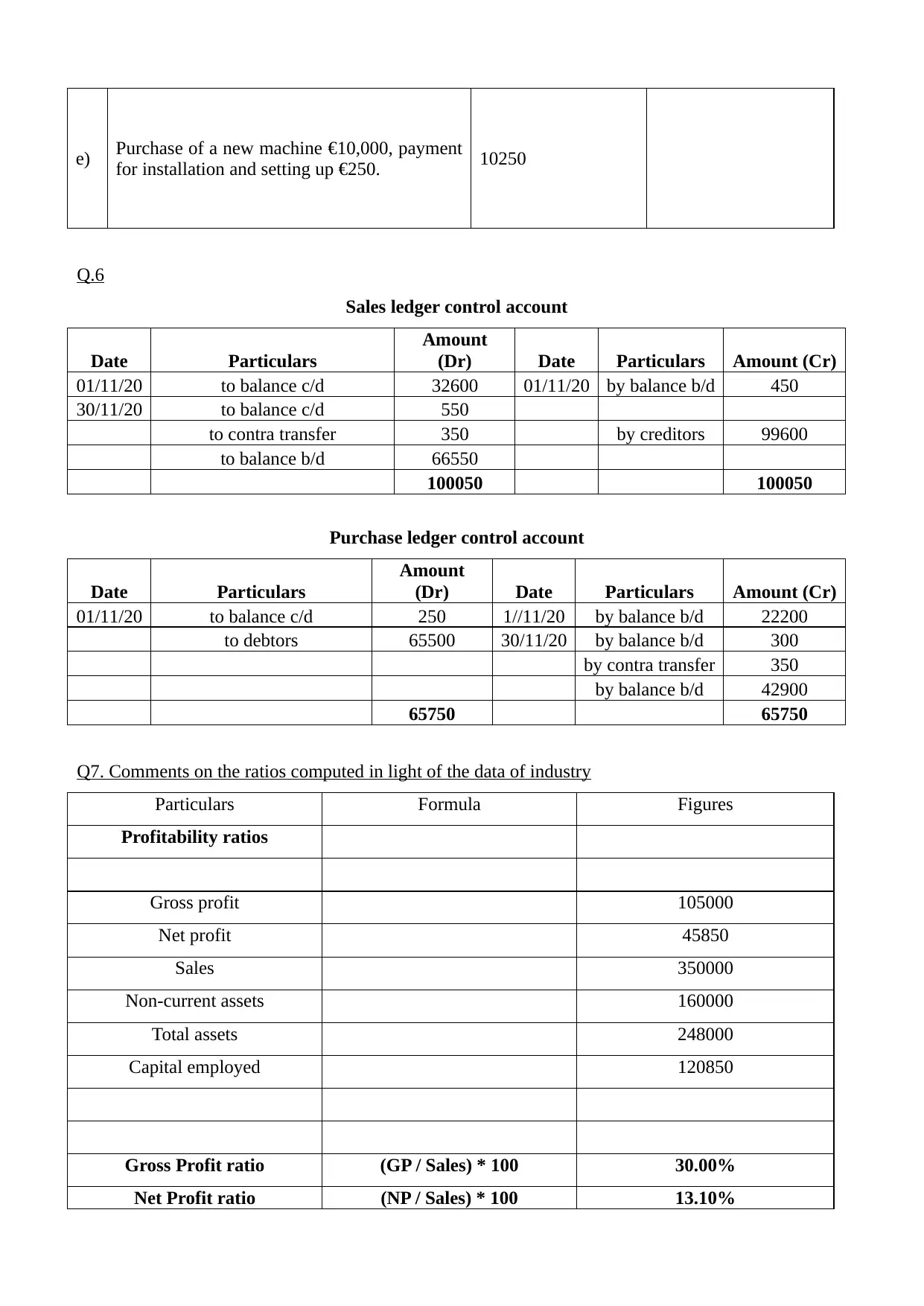
e) Purchase of a new machine €10,000, payment
for installation and setting up €250. 10250
Q.6
Sales ledger control account
Date Particulars
Amount
(Dr) Date Particulars Amount (Cr)
01/11/20 to balance c/d 32600 01/11/20 by balance b/d 450
30/11/20 to balance c/d 550
to contra transfer 350 by creditors 99600
to balance b/d 66550
100050 100050
Purchase ledger control account
Date Particulars
Amount
(Dr) Date Particulars Amount (Cr)
01/11/20 to balance c/d 250 1//11/20 by balance b/d 22200
to debtors 65500 30/11/20 by balance b/d 300
by contra transfer 350
by balance b/d 42900
65750 65750
Q7. Comments on the ratios computed in light of the data of industry
Particulars Formula Figures
Profitability ratios
Gross profit 105000
Net profit 45850
Sales 350000
Non-current assets 160000
Total assets 248000
Capital employed 120850
Gross Profit ratio (GP / Sales) * 100 30.00%
Net Profit ratio (NP / Sales) * 100 13.10%
for installation and setting up €250. 10250
Q.6
Sales ledger control account
Date Particulars
Amount
(Dr) Date Particulars Amount (Cr)
01/11/20 to balance c/d 32600 01/11/20 by balance b/d 450
30/11/20 to balance c/d 550
to contra transfer 350 by creditors 99600
to balance b/d 66550
100050 100050
Purchase ledger control account
Date Particulars
Amount
(Dr) Date Particulars Amount (Cr)
01/11/20 to balance c/d 250 1//11/20 by balance b/d 22200
to debtors 65500 30/11/20 by balance b/d 300
by contra transfer 350
by balance b/d 42900
65750 65750
Q7. Comments on the ratios computed in light of the data of industry
Particulars Formula Figures
Profitability ratios
Gross profit 105000
Net profit 45850
Sales 350000
Non-current assets 160000
Total assets 248000
Capital employed 120850
Gross Profit ratio (GP / Sales) * 100 30.00%
Net Profit ratio (NP / Sales) * 100 13.10%
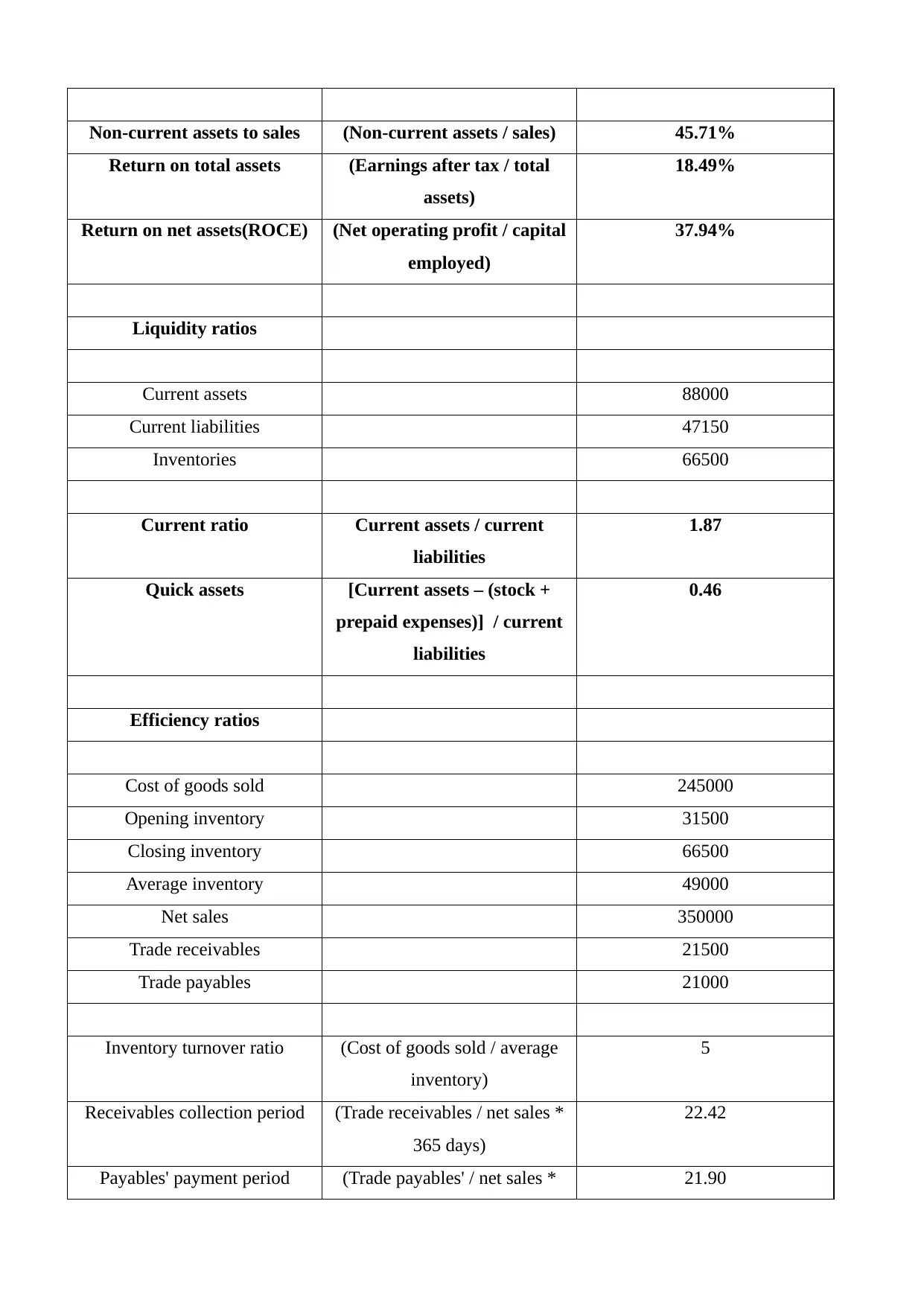
Non-current assets to sales (Non-current assets / sales) 45.71%
Return on total assets (Earnings after tax / total
assets)
18.49%
Return on net assets(ROCE) (Net operating profit / capital
employed)
37.94%
Liquidity ratios
Current assets 88000
Current liabilities 47150
Inventories 66500
Current ratio Current assets / current
liabilities
1.87
Quick assets [Current assets – (stock +
prepaid expenses)] / current
liabilities
0.46
Efficiency ratios
Cost of goods sold 245000
Opening inventory 31500
Closing inventory 66500
Average inventory 49000
Net sales 350000
Trade receivables 21500
Trade payables 21000
Inventory turnover ratio (Cost of goods sold / average
inventory)
5
Receivables collection period (Trade receivables / net sales *
365 days)
22.42
Payables' payment period (Trade payables' / net sales * 21.90
Return on total assets (Earnings after tax / total
assets)
18.49%
Return on net assets(ROCE) (Net operating profit / capital
employed)
37.94%
Liquidity ratios
Current assets 88000
Current liabilities 47150
Inventories 66500
Current ratio Current assets / current
liabilities
1.87
Quick assets [Current assets – (stock +
prepaid expenses)] / current
liabilities
0.46
Efficiency ratios
Cost of goods sold 245000
Opening inventory 31500
Closing inventory 66500
Average inventory 49000
Net sales 350000
Trade receivables 21500
Trade payables 21000
Inventory turnover ratio (Cost of goods sold / average
inventory)
5
Receivables collection period (Trade receivables / net sales *
365 days)
22.42
Payables' payment period (Trade payables' / net sales * 21.90
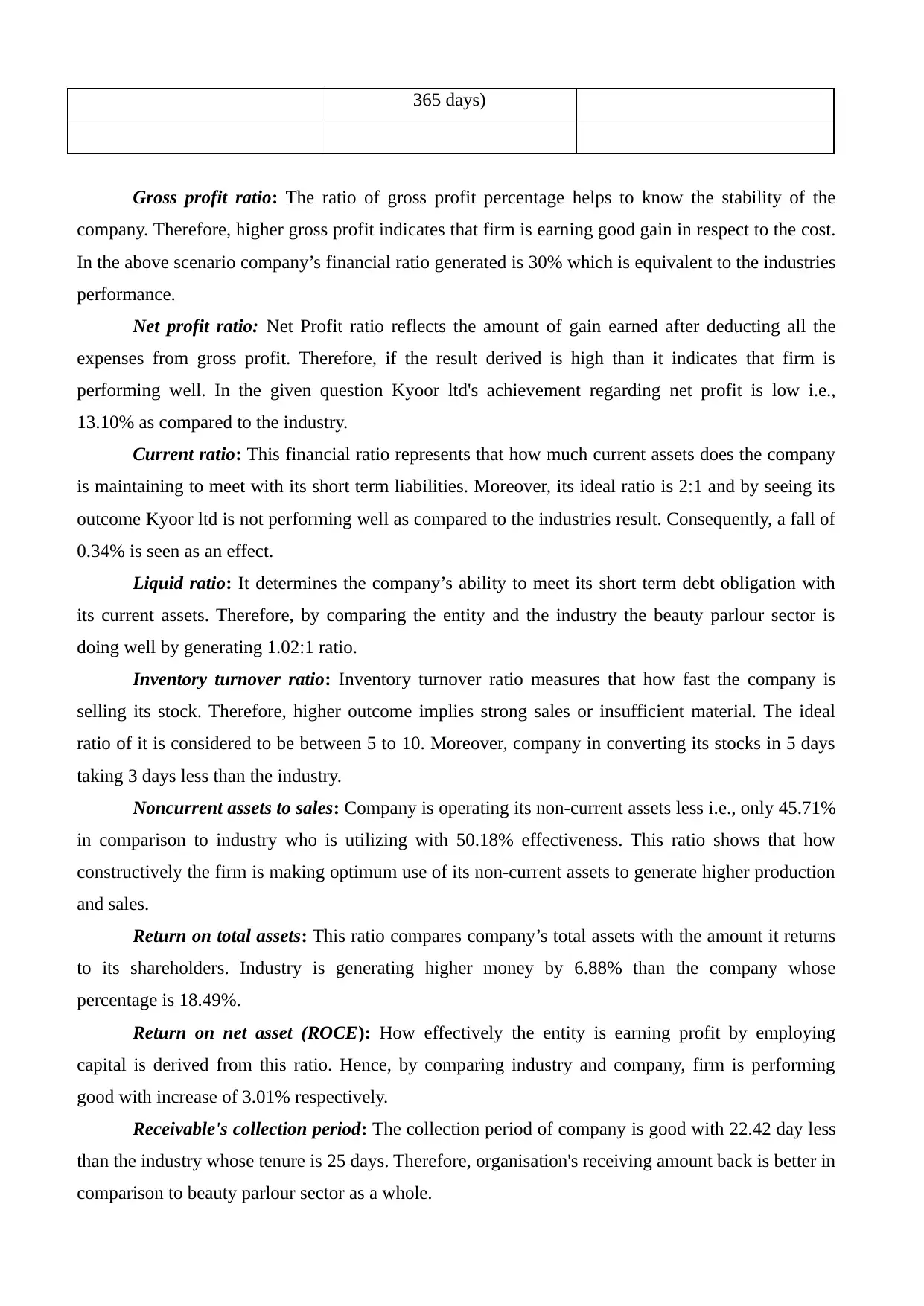
365 days)
Gross profit ratio: The ratio of gross profit percentage helps to know the stability of the
company. Therefore, higher gross profit indicates that firm is earning good gain in respect to the cost.
In the above scenario company’s financial ratio generated is 30% which is equivalent to the industries
performance.
Net profit ratio: Net Profit ratio reflects the amount of gain earned after deducting all the
expenses from gross profit. Therefore, if the result derived is high than it indicates that firm is
performing well. In the given question Kyoor ltd's achievement regarding net profit is low i.e.,
13.10% as compared to the industry.
Current ratio: This financial ratio represents that how much current assets does the company
is maintaining to meet with its short term liabilities. Moreover, its ideal ratio is 2:1 and by seeing its
outcome Kyoor ltd is not performing well as compared to the industries result. Consequently, a fall of
0.34% is seen as an effect.
Liquid ratio: It determines the company’s ability to meet its short term debt obligation with
its current assets. Therefore, by comparing the entity and the industry the beauty parlour sector is
doing well by generating 1.02:1 ratio.
Inventory turnover ratio: Inventory turnover ratio measures that how fast the company is
selling its stock. Therefore, higher outcome implies strong sales or insufficient material. The ideal
ratio of it is considered to be between 5 to 10. Moreover, company in converting its stocks in 5 days
taking 3 days less than the industry.
Noncurrent assets to sales: Company is operating its non-current assets less i.e., only 45.71%
in comparison to industry who is utilizing with 50.18% effectiveness. This ratio shows that how
constructively the firm is making optimum use of its non-current assets to generate higher production
and sales.
Return on total assets: This ratio compares company’s total assets with the amount it returns
to its shareholders. Industry is generating higher money by 6.88% than the company whose
percentage is 18.49%.
Return on net asset (ROCE): How effectively the entity is earning profit by employing
capital is derived from this ratio. Hence, by comparing industry and company, firm is performing
good with increase of 3.01% respectively.
Receivable's collection period: The collection period of company is good with 22.42 day less
than the industry whose tenure is 25 days. Therefore, organisation's receiving amount back is better in
comparison to beauty parlour sector as a whole.
Gross profit ratio: The ratio of gross profit percentage helps to know the stability of the
company. Therefore, higher gross profit indicates that firm is earning good gain in respect to the cost.
In the above scenario company’s financial ratio generated is 30% which is equivalent to the industries
performance.
Net profit ratio: Net Profit ratio reflects the amount of gain earned after deducting all the
expenses from gross profit. Therefore, if the result derived is high than it indicates that firm is
performing well. In the given question Kyoor ltd's achievement regarding net profit is low i.e.,
13.10% as compared to the industry.
Current ratio: This financial ratio represents that how much current assets does the company
is maintaining to meet with its short term liabilities. Moreover, its ideal ratio is 2:1 and by seeing its
outcome Kyoor ltd is not performing well as compared to the industries result. Consequently, a fall of
0.34% is seen as an effect.
Liquid ratio: It determines the company’s ability to meet its short term debt obligation with
its current assets. Therefore, by comparing the entity and the industry the beauty parlour sector is
doing well by generating 1.02:1 ratio.
Inventory turnover ratio: Inventory turnover ratio measures that how fast the company is
selling its stock. Therefore, higher outcome implies strong sales or insufficient material. The ideal
ratio of it is considered to be between 5 to 10. Moreover, company in converting its stocks in 5 days
taking 3 days less than the industry.
Noncurrent assets to sales: Company is operating its non-current assets less i.e., only 45.71%
in comparison to industry who is utilizing with 50.18% effectiveness. This ratio shows that how
constructively the firm is making optimum use of its non-current assets to generate higher production
and sales.
Return on total assets: This ratio compares company’s total assets with the amount it returns
to its shareholders. Industry is generating higher money by 6.88% than the company whose
percentage is 18.49%.
Return on net asset (ROCE): How effectively the entity is earning profit by employing
capital is derived from this ratio. Hence, by comparing industry and company, firm is performing
good with increase of 3.01% respectively.
Receivable's collection period: The collection period of company is good with 22.42 day less
than the industry whose tenure is 25 days. Therefore, organisation's receiving amount back is better in
comparison to beauty parlour sector as a whole.
Secure Best Marks with AI Grader
Need help grading? Try our AI Grader for instant feedback on your assignments.
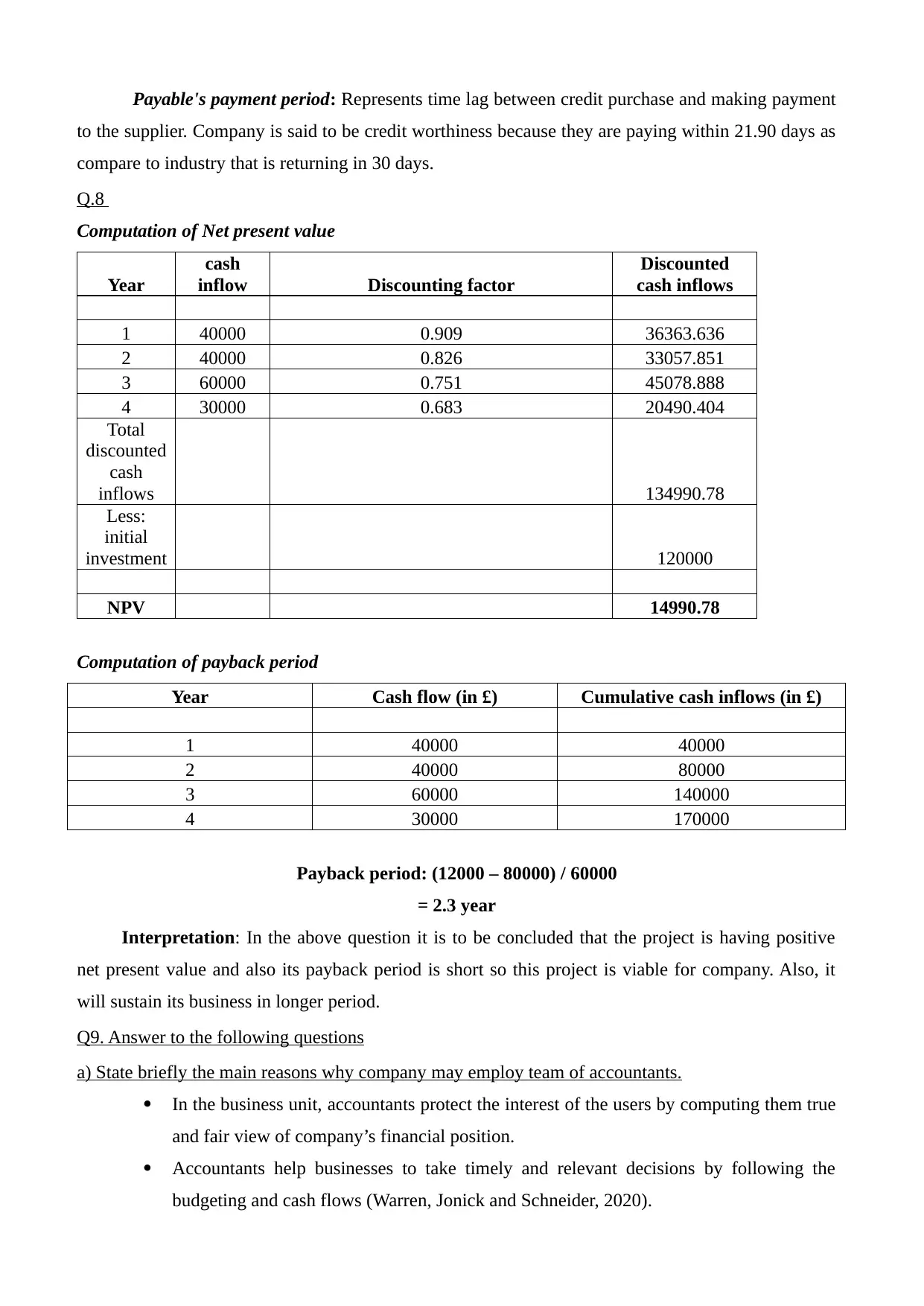
Payable's payment period: Represents time lag between credit purchase and making payment
to the supplier. Company is said to be credit worthiness because they are paying within 21.90 days as
compare to industry that is returning in 30 days.
Q.8
Computation of Net present value
Year
cash
inflow Discounting factor
Discounted
cash inflows
1 40000 0.909 36363.636
2 40000 0.826 33057.851
3 60000 0.751 45078.888
4 30000 0.683 20490.404
Total
discounted
cash
inflows 134990.78
Less:
initial
investment 120000
NPV 14990.78
Computation of payback period
Year Cash flow (in £) Cumulative cash inflows (in £)
1 40000 40000
2 40000 80000
3 60000 140000
4 30000 170000
Payback period: (12000 – 80000) / 60000
= 2.3 year
Interpretation: In the above question it is to be concluded that the project is having positive
net present value and also its payback period is short so this project is viable for company. Also, it
will sustain its business in longer period.
Q9. Answer to the following questions
a) State briefly the main reasons why company may employ team of accountants.
In the business unit, accountants protect the interest of the users by computing them true
and fair view of company’s financial position.
Accountants help businesses to take timely and relevant decisions by following the
budgeting and cash flows (Warren, Jonick and Schneider, 2020).
to the supplier. Company is said to be credit worthiness because they are paying within 21.90 days as
compare to industry that is returning in 30 days.
Q.8
Computation of Net present value
Year
cash
inflow Discounting factor
Discounted
cash inflows
1 40000 0.909 36363.636
2 40000 0.826 33057.851
3 60000 0.751 45078.888
4 30000 0.683 20490.404
Total
discounted
cash
inflows 134990.78
Less:
initial
investment 120000
NPV 14990.78
Computation of payback period
Year Cash flow (in £) Cumulative cash inflows (in £)
1 40000 40000
2 40000 80000
3 60000 140000
4 30000 170000
Payback period: (12000 – 80000) / 60000
= 2.3 year
Interpretation: In the above question it is to be concluded that the project is having positive
net present value and also its payback period is short so this project is viable for company. Also, it
will sustain its business in longer period.
Q9. Answer to the following questions
a) State briefly the main reasons why company may employ team of accountants.
In the business unit, accountants protect the interest of the users by computing them true
and fair view of company’s financial position.
Accountants help businesses to take timely and relevant decisions by following the
budgeting and cash flows (Warren, Jonick and Schneider, 2020).
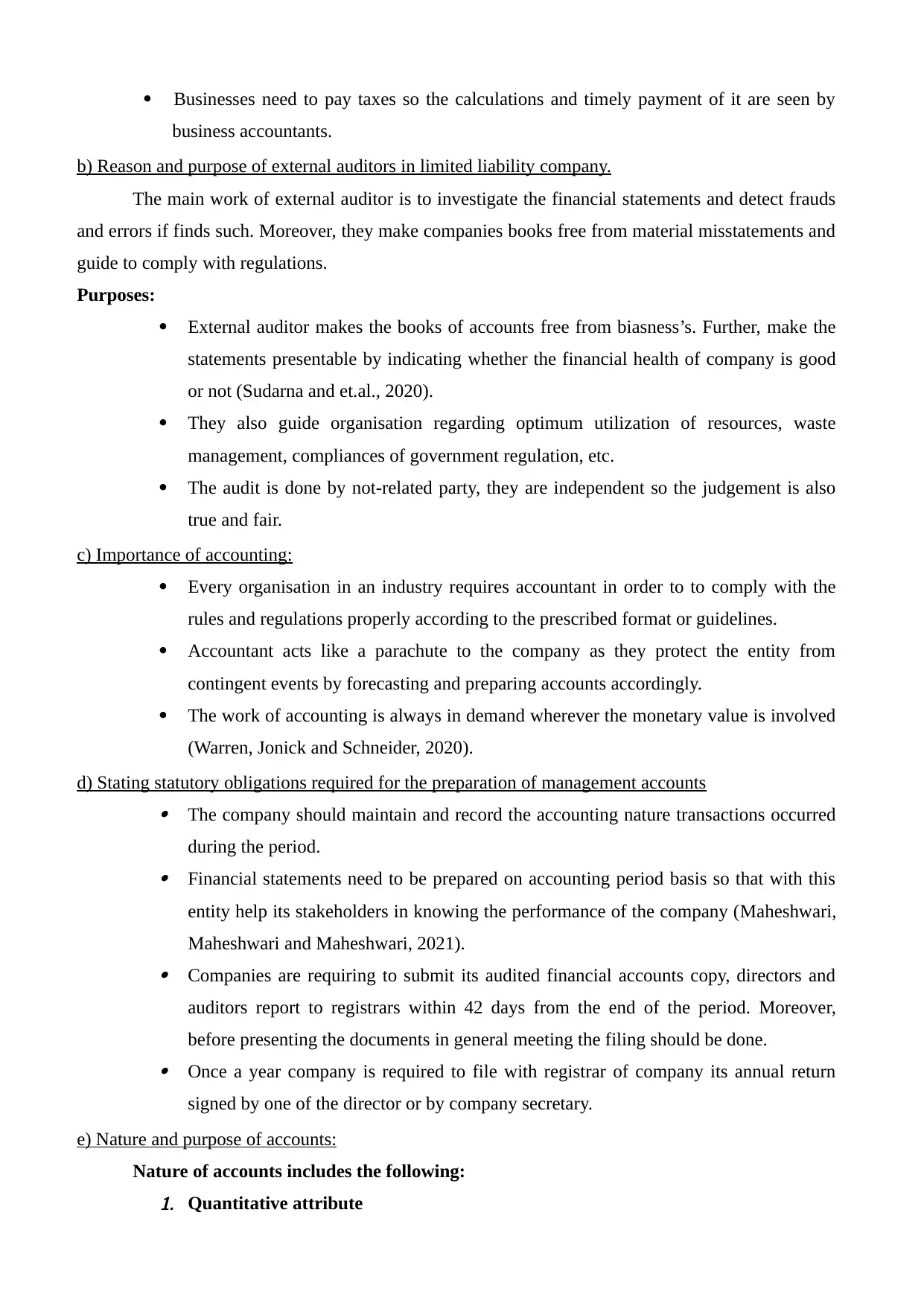
Businesses need to pay taxes so the calculations and timely payment of it are seen by
business accountants.
b) Reason and purpose of external auditors in limited liability company.
The main work of external auditor is to investigate the financial statements and detect frauds
and errors if finds such. Moreover, they make companies books free from material misstatements and
guide to comply with regulations.
Purposes:
External auditor makes the books of accounts free from biasness’s. Further, make the
statements presentable by indicating whether the financial health of company is good
or not (Sudarna and et.al., 2020).
They also guide organisation regarding optimum utilization of resources, waste
management, compliances of government regulation, etc.
The audit is done by not-related party, they are independent so the judgement is also
true and fair.
c) Importance of accounting:
Every organisation in an industry requires accountant in order to to comply with the
rules and regulations properly according to the prescribed format or guidelines.
Accountant acts like a parachute to the company as they protect the entity from
contingent events by forecasting and preparing accounts accordingly.
The work of accounting is always in demand wherever the monetary value is involved
(Warren, Jonick and Schneider, 2020).
d) Stating statutory obligations required for the preparation of management accounts
The company should maintain and record the accounting nature transactions occurred
during the period.
Financial statements need to be prepared on accounting period basis so that with this
entity help its stakeholders in knowing the performance of the company (Maheshwari,
Maheshwari and Maheshwari, 2021).
Companies are requiring to submit its audited financial accounts copy, directors and
auditors report to registrars within 42 days from the end of the period. Moreover,
before presenting the documents in general meeting the filing should be done.
Once a year company is required to file with registrar of company its annual return
signed by one of the director or by company secretary.
e) Nature and purpose of accounts:
Nature of accounts includes the following:
1. Quantitative attribute
business accountants.
b) Reason and purpose of external auditors in limited liability company.
The main work of external auditor is to investigate the financial statements and detect frauds
and errors if finds such. Moreover, they make companies books free from material misstatements and
guide to comply with regulations.
Purposes:
External auditor makes the books of accounts free from biasness’s. Further, make the
statements presentable by indicating whether the financial health of company is good
or not (Sudarna and et.al., 2020).
They also guide organisation regarding optimum utilization of resources, waste
management, compliances of government regulation, etc.
The audit is done by not-related party, they are independent so the judgement is also
true and fair.
c) Importance of accounting:
Every organisation in an industry requires accountant in order to to comply with the
rules and regulations properly according to the prescribed format or guidelines.
Accountant acts like a parachute to the company as they protect the entity from
contingent events by forecasting and preparing accounts accordingly.
The work of accounting is always in demand wherever the monetary value is involved
(Warren, Jonick and Schneider, 2020).
d) Stating statutory obligations required for the preparation of management accounts
The company should maintain and record the accounting nature transactions occurred
during the period.
Financial statements need to be prepared on accounting period basis so that with this
entity help its stakeholders in knowing the performance of the company (Maheshwari,
Maheshwari and Maheshwari, 2021).
Companies are requiring to submit its audited financial accounts copy, directors and
auditors report to registrars within 42 days from the end of the period. Moreover,
before presenting the documents in general meeting the filing should be done.
Once a year company is required to file with registrar of company its annual return
signed by one of the director or by company secretary.
e) Nature and purpose of accounts:
Nature of accounts includes the following:
1. Quantitative attribute
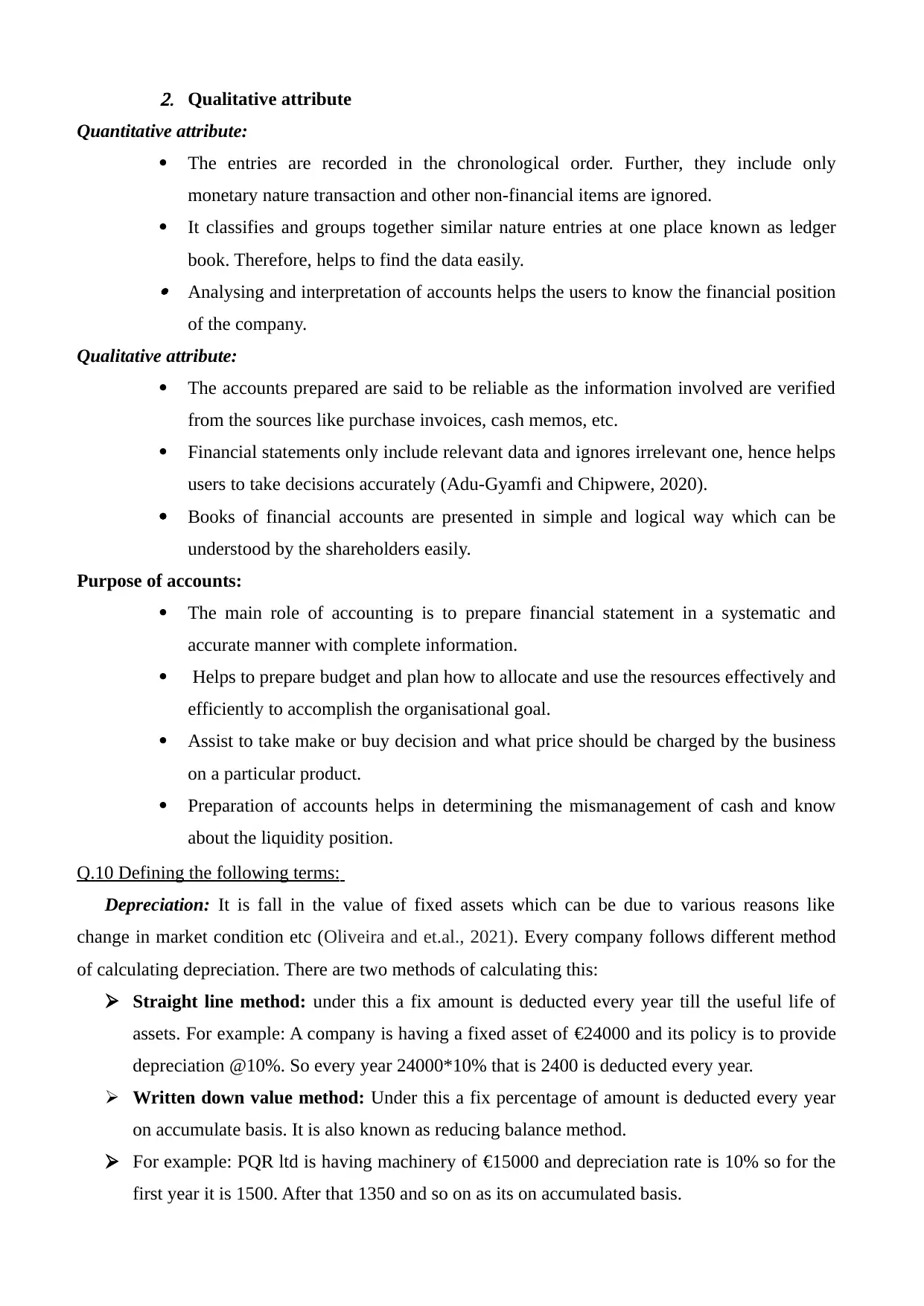
2. Qualitative attribute
Quantitative attribute:
The entries are recorded in the chronological order. Further, they include only
monetary nature transaction and other non-financial items are ignored.
It classifies and groups together similar nature entries at one place known as ledger
book. Therefore, helps to find the data easily.
Analysing and interpretation of accounts helps the users to know the financial position
of the company.
Qualitative attribute:
The accounts prepared are said to be reliable as the information involved are verified
from the sources like purchase invoices, cash memos, etc.
Financial statements only include relevant data and ignores irrelevant one, hence helps
users to take decisions accurately (Adu-Gyamfi and Chipwere, 2020).
Books of financial accounts are presented in simple and logical way which can be
understood by the shareholders easily.
Purpose of accounts:
The main role of accounting is to prepare financial statement in a systematic and
accurate manner with complete information.
Helps to prepare budget and plan how to allocate and use the resources effectively and
efficiently to accomplish the organisational goal.
Assist to take make or buy decision and what price should be charged by the business
on a particular product.
Preparation of accounts helps in determining the mismanagement of cash and know
about the liquidity position.
Q.10 Defining the following terms:
Depreciation: It is fall in the value of fixed assets which can be due to various reasons like
change in market condition etc (Oliveira and et.al., 2021). Every company follows different method
of calculating depreciation. There are two methods of calculating this:
Straight line method: under this a fix amount is deducted every year till the useful life of
assets. For example: A company is having a fixed asset of €24000 and its policy is to provide
depreciation @10%. So every year 24000*10% that is 2400 is deducted every year.
Written down value method: Under this a fix percentage of amount is deducted every year
on accumulate basis. It is also known as reducing balance method.
For example: PQR ltd is having machinery of €15000 and depreciation rate is 10% so for the
first year it is 1500. After that 1350 and so on as its on accumulated basis.
Quantitative attribute:
The entries are recorded in the chronological order. Further, they include only
monetary nature transaction and other non-financial items are ignored.
It classifies and groups together similar nature entries at one place known as ledger
book. Therefore, helps to find the data easily.
Analysing and interpretation of accounts helps the users to know the financial position
of the company.
Qualitative attribute:
The accounts prepared are said to be reliable as the information involved are verified
from the sources like purchase invoices, cash memos, etc.
Financial statements only include relevant data and ignores irrelevant one, hence helps
users to take decisions accurately (Adu-Gyamfi and Chipwere, 2020).
Books of financial accounts are presented in simple and logical way which can be
understood by the shareholders easily.
Purpose of accounts:
The main role of accounting is to prepare financial statement in a systematic and
accurate manner with complete information.
Helps to prepare budget and plan how to allocate and use the resources effectively and
efficiently to accomplish the organisational goal.
Assist to take make or buy decision and what price should be charged by the business
on a particular product.
Preparation of accounts helps in determining the mismanagement of cash and know
about the liquidity position.
Q.10 Defining the following terms:
Depreciation: It is fall in the value of fixed assets which can be due to various reasons like
change in market condition etc (Oliveira and et.al., 2021). Every company follows different method
of calculating depreciation. There are two methods of calculating this:
Straight line method: under this a fix amount is deducted every year till the useful life of
assets. For example: A company is having a fixed asset of €24000 and its policy is to provide
depreciation @10%. So every year 24000*10% that is 2400 is deducted every year.
Written down value method: Under this a fix percentage of amount is deducted every year
on accumulate basis. It is also known as reducing balance method.
For example: PQR ltd is having machinery of €15000 and depreciation rate is 10% so for the
first year it is 1500. After that 1350 and so on as its on accumulated basis.
Paraphrase This Document
Need a fresh take? Get an instant paraphrase of this document with our AI Paraphraser
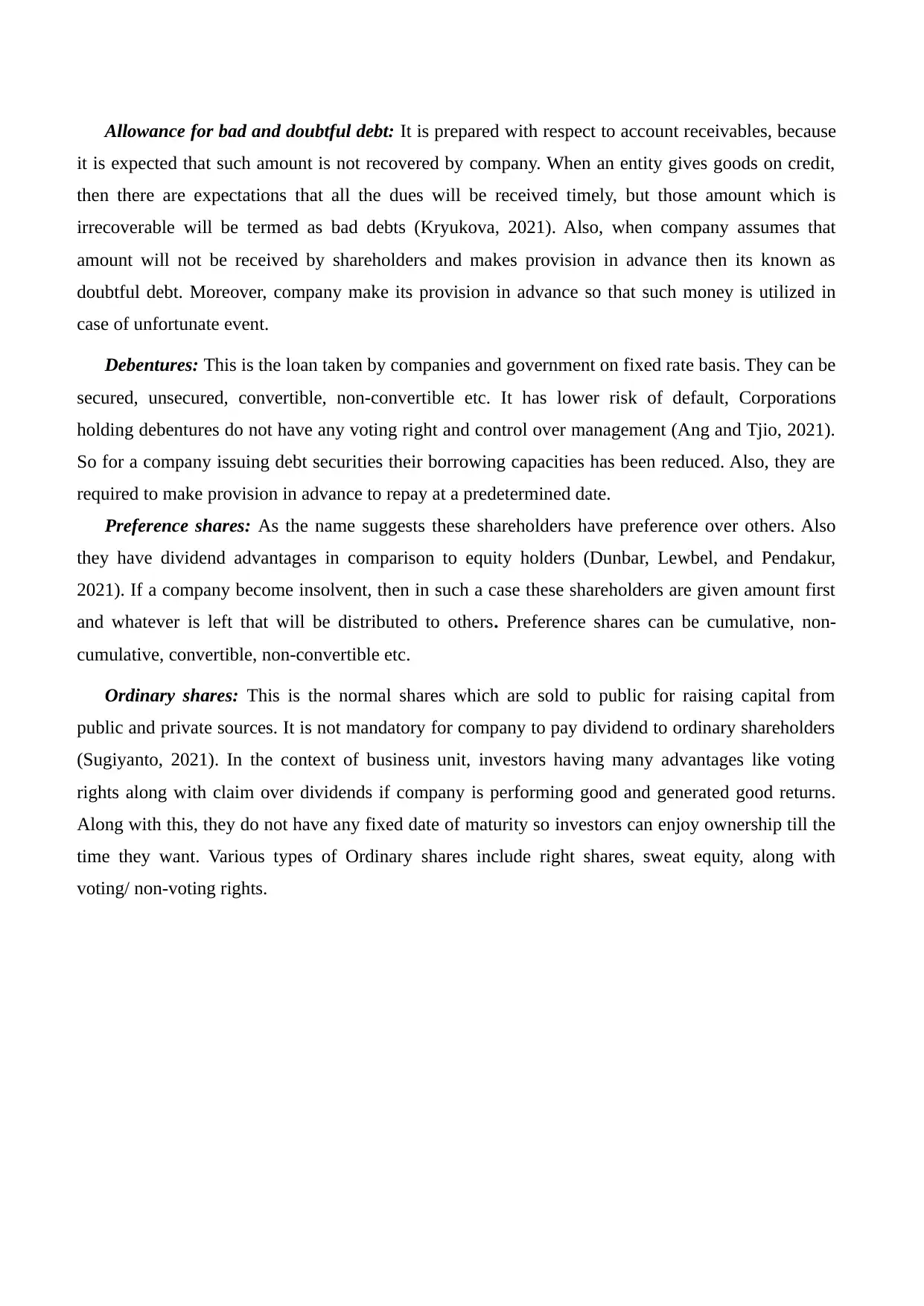
Allowance for bad and doubtful debt: It is prepared with respect to account receivables, because
it is expected that such amount is not recovered by company. When an entity gives goods on credit,
then there are expectations that all the dues will be received timely, but those amount which is
irrecoverable will be termed as bad debts (Kryukova, 2021). Also, when company assumes that
amount will not be received by shareholders and makes provision in advance then its known as
doubtful debt. Moreover, company make its provision in advance so that such money is utilized in
case of unfortunate event.
Debentures: This is the loan taken by companies and government on fixed rate basis. They can be
secured, unsecured, convertible, non-convertible etc. It has lower risk of default, Corporations
holding debentures do not have any voting right and control over management (Ang and Tjio, 2021).
So for a company issuing debt securities their borrowing capacities has been reduced. Also, they are
required to make provision in advance to repay at a predetermined date.
Preference shares: As the name suggests these shareholders have preference over others. Also
they have dividend advantages in comparison to equity holders (Dunbar, Lewbel, and Pendakur,
2021). If a company become insolvent, then in such a case these shareholders are given amount first
and whatever is left that will be distributed to others. Preference shares can be cumulative, non-
cumulative, convertible, non-convertible etc.
Ordinary shares: This is the normal shares which are sold to public for raising capital from
public and private sources. It is not mandatory for company to pay dividend to ordinary shareholders
(Sugiyanto, 2021). In the context of business unit, investors having many advantages like voting
rights along with claim over dividends if company is performing good and generated good returns.
Along with this, they do not have any fixed date of maturity so investors can enjoy ownership till the
time they want. Various types of Ordinary shares include right shares, sweat equity, along with
voting/ non-voting rights.
it is expected that such amount is not recovered by company. When an entity gives goods on credit,
then there are expectations that all the dues will be received timely, but those amount which is
irrecoverable will be termed as bad debts (Kryukova, 2021). Also, when company assumes that
amount will not be received by shareholders and makes provision in advance then its known as
doubtful debt. Moreover, company make its provision in advance so that such money is utilized in
case of unfortunate event.
Debentures: This is the loan taken by companies and government on fixed rate basis. They can be
secured, unsecured, convertible, non-convertible etc. It has lower risk of default, Corporations
holding debentures do not have any voting right and control over management (Ang and Tjio, 2021).
So for a company issuing debt securities their borrowing capacities has been reduced. Also, they are
required to make provision in advance to repay at a predetermined date.
Preference shares: As the name suggests these shareholders have preference over others. Also
they have dividend advantages in comparison to equity holders (Dunbar, Lewbel, and Pendakur,
2021). If a company become insolvent, then in such a case these shareholders are given amount first
and whatever is left that will be distributed to others. Preference shares can be cumulative, non-
cumulative, convertible, non-convertible etc.
Ordinary shares: This is the normal shares which are sold to public for raising capital from
public and private sources. It is not mandatory for company to pay dividend to ordinary shareholders
(Sugiyanto, 2021). In the context of business unit, investors having many advantages like voting
rights along with claim over dividends if company is performing good and generated good returns.
Along with this, they do not have any fixed date of maturity so investors can enjoy ownership till the
time they want. Various types of Ordinary shares include right shares, sweat equity, along with
voting/ non-voting rights.
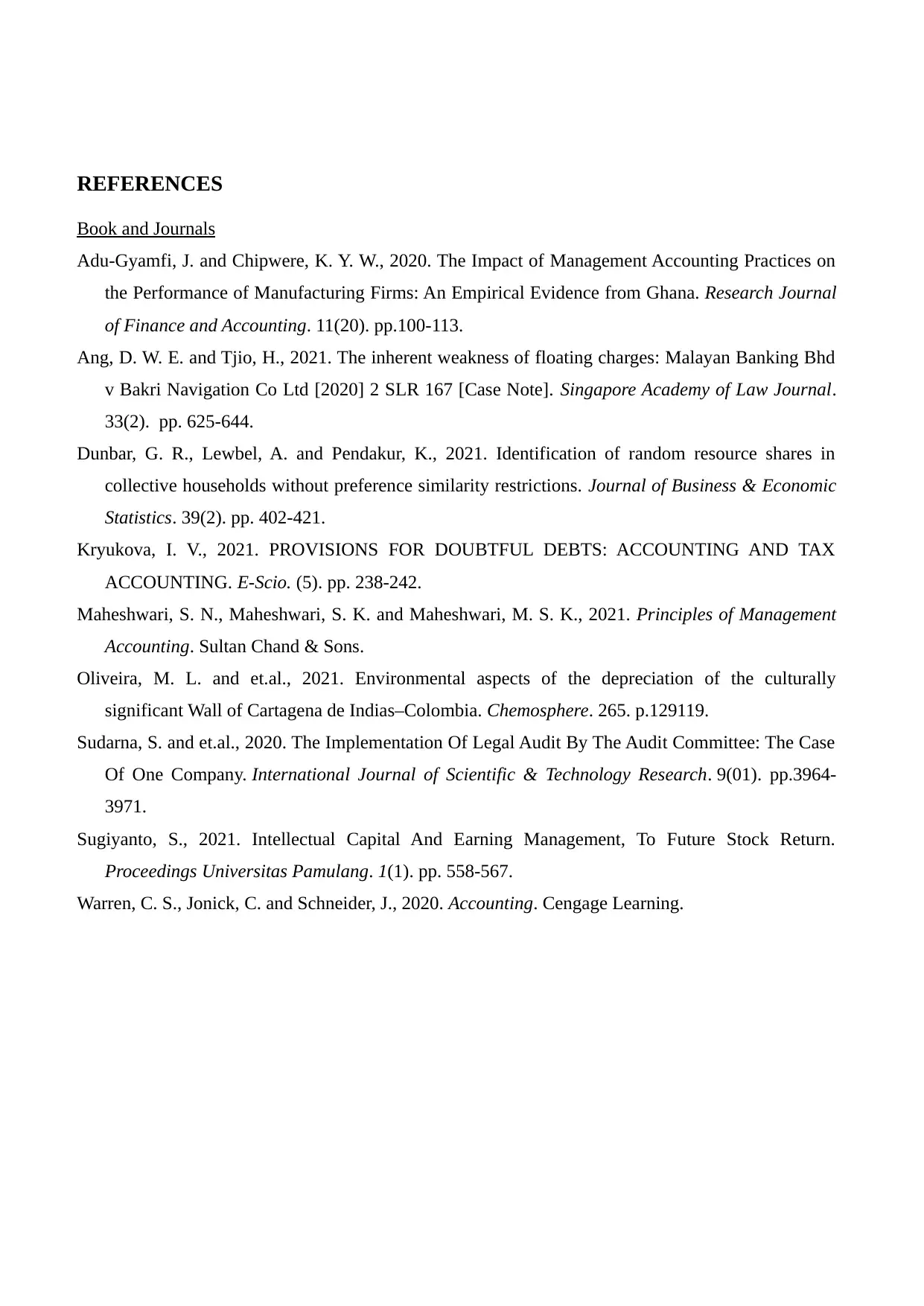
REFERENCES
Book and Journals
Adu-Gyamfi, J. and Chipwere, K. Y. W., 2020. The Impact of Management Accounting Practices on
the Performance of Manufacturing Firms: An Empirical Evidence from Ghana. Research Journal
of Finance and Accounting. 11(20). pp.100-113.
Ang, D. W. E. and Tjio, H., 2021. The inherent weakness of floating charges: Malayan Banking Bhd
v Bakri Navigation Co Ltd [2020] 2 SLR 167 [Case Note]. Singapore Academy of Law Journal.
33(2). pp. 625-644.
Dunbar, G. R., Lewbel, A. and Pendakur, K., 2021. Identification of random resource shares in
collective households without preference similarity restrictions. Journal of Business & Economic
Statistics. 39(2). pp. 402-421.
Kryukova, I. V., 2021. PROVISIONS FOR DOUBTFUL DEBTS: ACCOUNTING AND TAX
ACCOUNTING. E-Scio. (5). pp. 238-242.
Maheshwari, S. N., Maheshwari, S. K. and Maheshwari, M. S. K., 2021. Principles of Management
Accounting. Sultan Chand & Sons.
Oliveira, M. L. and et.al., 2021. Environmental aspects of the depreciation of the culturally
significant Wall of Cartagena de Indias–Colombia. Chemosphere. 265. p.129119.
Sudarna, S. and et.al., 2020. The Implementation Of Legal Audit By The Audit Committee: The Case
Of One Company. International Journal of Scientific & Technology Research. 9(01). pp.3964-
3971.
Sugiyanto, S., 2021. Intellectual Capital And Earning Management, To Future Stock Return.
Proceedings Universitas Pamulang. 1(1). pp. 558-567.
Warren, C. S., Jonick, C. and Schneider, J., 2020. Accounting. Cengage Learning.
Book and Journals
Adu-Gyamfi, J. and Chipwere, K. Y. W., 2020. The Impact of Management Accounting Practices on
the Performance of Manufacturing Firms: An Empirical Evidence from Ghana. Research Journal
of Finance and Accounting. 11(20). pp.100-113.
Ang, D. W. E. and Tjio, H., 2021. The inherent weakness of floating charges: Malayan Banking Bhd
v Bakri Navigation Co Ltd [2020] 2 SLR 167 [Case Note]. Singapore Academy of Law Journal.
33(2). pp. 625-644.
Dunbar, G. R., Lewbel, A. and Pendakur, K., 2021. Identification of random resource shares in
collective households without preference similarity restrictions. Journal of Business & Economic
Statistics. 39(2). pp. 402-421.
Kryukova, I. V., 2021. PROVISIONS FOR DOUBTFUL DEBTS: ACCOUNTING AND TAX
ACCOUNTING. E-Scio. (5). pp. 238-242.
Maheshwari, S. N., Maheshwari, S. K. and Maheshwari, M. S. K., 2021. Principles of Management
Accounting. Sultan Chand & Sons.
Oliveira, M. L. and et.al., 2021. Environmental aspects of the depreciation of the culturally
significant Wall of Cartagena de Indias–Colombia. Chemosphere. 265. p.129119.
Sudarna, S. and et.al., 2020. The Implementation Of Legal Audit By The Audit Committee: The Case
Of One Company. International Journal of Scientific & Technology Research. 9(01). pp.3964-
3971.
Sugiyanto, S., 2021. Intellectual Capital And Earning Management, To Future Stock Return.
Proceedings Universitas Pamulang. 1(1). pp. 558-567.
Warren, C. S., Jonick, C. and Schneider, J., 2020. Accounting. Cengage Learning.
1 out of 15
Related Documents
Your All-in-One AI-Powered Toolkit for Academic Success.
+13062052269
info@desklib.com
Available 24*7 on WhatsApp / Email
![[object Object]](/_next/static/media/star-bottom.7253800d.svg)
Unlock your academic potential
© 2024 | Zucol Services PVT LTD | All rights reserved.




